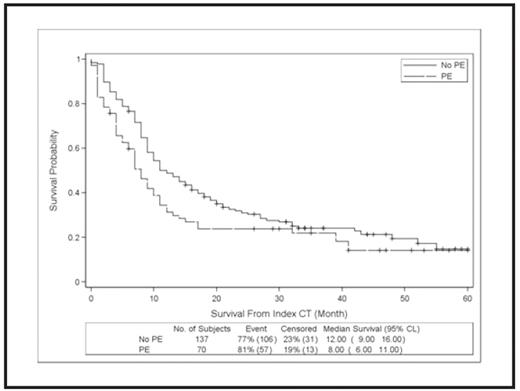Abstract
Background: While symptomatic venous thromboemboli (VTE) clearly have an adverse impact on survival among cancer patients, the outcome of cancer patients with unsuspected pulmonary emboli (PE) found on routine cancer staging multi-row detector CT (MDCT) scans is unknown. In order to evaluate survival among cancer patients with unsuspected PE, we expanded on a previous study (
Methods: We performed a retrospective chart review of cancer patients with unsuspected PE found on routine cancer staging MDCT scans between May, 2003 and August, 2006. Two patients matched for age, cancer type and stage (“controls”) were identified for each patient with unsuspected PE (“cases”). Patients with known VTE, patients already receiving anticoagulation for any reason and patients with multiple active cancers were excluded. We recorded cancer characteristics, signs and symptoms typical of PE, risk factors, presence of PE on subsequent staging scans, time to death, and cause of death. We used conditional logistic regression analysis to compare the baseline characteristics. To evaluate the impact of unsuspected PE and other covariates on survival, we used stratified Cox proportional hazard analysis and the logrank test.
Results: Seventy patients with unsuspected PE and 137 matched controls were evaluated. There were no significant differences between the groups in terms of matching factors, gender, or sites of metastases. Cases were more likely to have had prior VTE and to have had surgery within the previous 2 months than were controls (p=0.008, p=0.0002, respectively). There were no differences in the time from cancer diagnosis to the index MDCT scan, use of erythropoietin, exposure to chemotherapy, presence of central lines, hormonal therapy or use of antiplatelet medication between cases and controls. As previously reported in the smaller series, cases were more likely to actually have complained to someone on the medical team of shortness of breath and fatigue than were control patients (p =0.0009, p=0.001, respectively); case patients were also more likely than control patients to complain of cough (p=0.019). There were no statistically significant differences in other signs or symptoms such as hypoxia, fever, limb pain or swelling, chest pain or tachycardia. Of the 70 patients with unsuspected PE, 17 (24.3%) had isolated subsegmental clots and 53 (75.7%) had more proximal clots. Fifty-nine of the 70 patients (84.3%) with PE received some form of anticoagulation as treatment. Using a stratified analysis adjusting for the presence of brain, liver and lung metastases and for use of erythropoietin we found that proximal unsuspected PE conferred a hazard ratio for death of 1.79 (95% CI 1.10–2.90, p =0.018) (Kaplan-Meier curves, Figure 1). Symptomatic patients with unsuspected proximal PE, in particular, had poorer overall survival than matched controls (5 months vs. 14 months, p=0.009, logrank test). Use of erythropoietin, metastases to lung, liver or lymph nodes, gender, and active treatment with chemotherapy had no significant impact on survival; brain metastases, however, conferred poorer overall survival (20.5 vs. 61 months, p=0.003) independent of PE.
Conclusion: These data support our previous findings in the smaller series that patients with unsuspected PE detected on routine staging MDCT scans are more likely to be symptomatic than are matched control patients, particularly with shortness of breath, fatigue and cough. Unsuspected PE have a significant adverse impact on overall survival among cancer patients; this impact is more pronounced among those patients reporting PE-related symptoms.
SEQ Figure \* ARABIC 1. Overall survival among cancer patients with unsuspected PE and matched controls
SEQ Figure \* ARABIC 1. Overall survival among cancer patients with unsuspected PE and matched controls
Disclosures: No relevant conflicts of interest to declare.
Author notes
Corresponding author


This feature is available to Subscribers Only
Sign In or Create an Account Close Modal